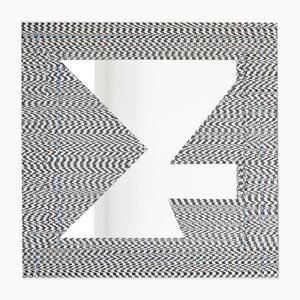Briggs & Cole present musically inspired designs
No Line No Wave
For its No Line No Wave collection, Scottish design studio Briggs & Cole invited 12 Glasgow-based artists and designers to each create a scarf design based on their individual interpretations of the theme “music and collage.” The resulting scarves—13 designs (Briggs & Cole designed one as well)—were produced in limited editions of 10 each, all numbered by hand and printed on 100% silk, and first debuted in December at a pop-up exhibition by the same name at Graven Images HQ in Glasgow.
We chatted with designers Jane Briggs and Christy Cole about their remarkable project, the value they place on making and producing work in Scotland, and their take on the Scottish creative scene, both today and tomorrow.
AC: How did you arrive at the starting point for this project—the connection between collage and music?
B&C: The term "no wave" references, in part, a punk subculture [that rejected commercialism] and the then-popular new wave genre. Known as “New York No Wave” in downtown New York circa 1978 to the early 1980s, the movement lasted a relatively short time, but profoundly influenced the development of independent film, fashion, design, and visual art. It’s interesting to think about the simultaneous discord and accumulative layering (applied through collage imagery and music) when you consider today's proliferation and oversaturation of imagery relating to French New Wave pioneer Jean-Luc Godard when he remarked: “There are no new waves, there is only the ocean.”
AC: What brief were the makers given?
B&C: Each participant was asked to respond to the idea of designing a collage based on what they felt was the most personal or pertinent aspect of experiencing/enacting meaning through music. So the main motivation was to carefully think about the design of each scarf not only for the given subject matter or aesthetic purpose, but for the nature of its function as a wearable item. Each scarf therefore has a title and brief description from each participant on how the design/creation/narrative behind the process came into realization.
AC: How did you choose your collaborators?
B&C: The majority of participants are a mixture of of Irish, English, and Scottish descent, but fundamentally they have all chosen to live and work in Glasgow over a longer period of time. We primarily chose these individuals as we were familiar with their practices and because they are outstanding in their field of work. It was a conscious decision to select individuals who think and challenge their practice—artists who double up as musicians; designers who don’t always work in collage; an accomplished sound collagist to design an image based on his practice. Overall, the collages they produced engender a high quality of craftsmanship, thought, and detail, with an extraordinary, energizing zeal and wit.
AC: Tell us a bit more about the printing process, and the printer's role in the project.
B&C: We closely worked alongside the textile technical team based at the Center for Advanced Textiles, Glasgow School of Art. We [benefitted from] their knowledge and expertise regarding color saturation, dyeing, material application and testing right through to hand finishing. We were really conscious of understanding where the silk material is sourced from, and keeping this close to our values of making and producing in Scotland. In this particular instance, we worked with a local artisan seamstress who diligently hand-roll-finished each and every silk piece.
AC: How would you describe Glasgow's current design scene? And how is this different from 5/10 years ago, and where do you anticipate (or hope) the scene will be 5 years from now?
B&C: To date, the design scene here in Glasgow has always defied categorization, renowned for quietly yet confidently cultivating and attracting a very diverse and culturally attuned range of practices and individuals. By definition, it has an undeniable charm and innate willingness to be open, friendly, and collaborative. When you look at, say, 10 years ago, the cultural landscape for design was quite different; not quite non-existent, but perhaps less restless than the current appetite for a more inclusive and progressive policy for design in Scotland as we [look] to the future. Despite all the obvious challenges and success that come with the aforementioned values, we firmly believe that Scotland’s influence can be more developed and fully mapped out as an international destination for design. We are very much looking forward to helping shape and contribute to Glasgow’s 2016 Festival of Architecture & Design. We think this will be a good cultural barometer for ongoing change, and we hope that we have really well-considered and curated, design-led projects that will become synonymous here in Scotland.
AC: Thanks Christy and Jane!
For more info, visit our Shop or www.briggsandcole.co.uk
-
Text by
-
Anna Carnick
Anna is Pamono’s Managing Editor. Her writing has appeared in several arts and culture publications, and she's edited over 20 books. Anna loves celebrating great artists, and seriously enjoys a good picnic.
-





